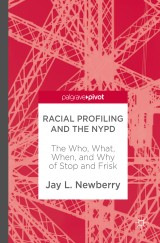Details

Racial Profiling and the NYPD
The Who, What, When, and Why of Stop and Frisk|
58,84 € |
|
| Verlag: | Palgrave Macmillan |
| Format: | |
| Veröffentl.: | 15.06.2017 |
| ISBN/EAN: | 9783319580913 |
| Sprache: | englisch |
Dieses eBook enthält ein Wasserzeichen.
Beschreibungen
<p>This book analyzes New York City’s stop-and-frisk data both pre- and post-constitutionality ruling, examining the existence of both profiling and unequal treatment among the three largest groups identified in the database: Blacks, Whites, and Hispanics. The purpose for using these two time periods is to determine which group(s) benefited the most from the ruling. This research goes beyond standard statistics to identify the place that race holds in contributing to the stop disparities. Specifically, this research will adds a spatial element to the numbers by analyzing the determinants of stop location by race, applying a principal component analysis to a mixture of census and stop-and-frisk data to determine the influence of location on stops by race. The results present a way of determining the plausibility of stops being the product of racial profiling–or just a matter of happenstance.<br></p>
<div>Table of Contents</div><div>Acknowledgments ii</div><div>List of Tables v</div><div>List of Figures v</div><div>INTRODUCTION 1</div><div>Progression of Text 4</div><div>Importance of this Work 6</div><div>Bibliography 6</div><div>CHAPTER ONE: IN THE SHADOW OF LADY LIBERTY 8</div><div>The Legal Basis for Stop-and-Frisk 9</div><div>Darker Days in The Big Apple 13</div><div>The Stop-and-Frisk Credit Contradiction 14</div><div>The Brownsville Blitz 16</div><div>Bringing up the Numbers 17</div><div>Bibliography 19</div><div>CHAPTER TWO: BROKEN WINDOWS OR BREAKING COMMUNITIES 22</div><div>Criticisms of Broken Windows 24</div><div>Breaking Windows and the Quality of Life 25</div><div>Policing the Community or Policing for the Community 28</div><div>Bibliography 36</div><div>CHAPTER THREE: THE IMPACT OF BROKEN WINDOW ON POLICE PRACTICES IN NEW YORK CITY 38</div><div>The Trends 40</div><div>The Constitutionality Challenge 42</div><div>The Cause? 43</div><div>Bibliography 45</div><div>CHAPTER FOUR: ANALYTICAL METHODS 47</div><div>Analytical Methods 49</div><div>The Principal Component Analysis 49</div><div>The PCA Data and Procedures 50</div><div>The Data Envelopment Analysis 52</div><div>The Location 53</div><div>Bibliography 54</div><div>CHAPTER FIVE: ANALYTICAL RESULTS 56</div><div>The Principal Component Analysis Dimension Extraction Results 56</div><div>PCA Regression Results for 2012 57</div><div>PCA Regression Results for 2014 59</div><div>The Data Envelopment Analysis Results 60</div><div>Group Efficiency Results 60</div><div>Borough Level Efficiency 63</div><div>The Best and the Worst Precincts 63</div><div>CHAPTER 6: DISCUSSION AND CONCLUSION 65</div><div>Discussion 66</div><div>Stop-and-Frisk Environments 68</div><div>Stop-and-Fisk Efficiency 71</div><div>Conclusion 72</div><div>Bibliography 75</div><div>Index 76</div><div><br></div>
Jay L. Newberry is Assistant Professor of Geography at Binghamton University
<p>This book analyzes New York City’s stop-and-frisk data both pre- and post-constitutionality ruling, examining the existence of both profiling and unequal treatment among the three largest groups identified in the database: Blacks, Whites, and Hispanics. The purpose for using these two time periods is to determine which group(s) benefited the most from the ruling. This research goes beyond standard statistics to identify the place that race holds in contributing to the stop disparities. Specifically, this research will adds a spatial element to the numbers by analyzing the determinants of stop location by race, applying a principal component analysis to a mixture of census and stop-and-frisk data to determine the influence of location on stops by race. The results present a way of determining the plausibility of stops being the product of racial profiling–or just a matter of happenstance.<br></p>
<p>Appeals to urban geographers, sociologists and criminal justice researchers examining the rise of the stop-and-frisk policy internationally</p><p>Grounded in empirically research and statistically strong analysis of census data</p><p>Answers the question of whether or not the constitutional ruling of stop-and-frisk has had an impact on the way in which stop-and-frisk is carried out</p><p>Includes supplementary material: sn.pub/extras</p><p>Includes supplementary material: sn.pub/extras</p>
Diese Produkte könnten Sie auch interessieren:

Der Aufstand der Jugendlichen in den Banlieues: Eine Analyse der Pariser Unruhen von 2005

von: Ahmed El- Mamouni

23,00 €















